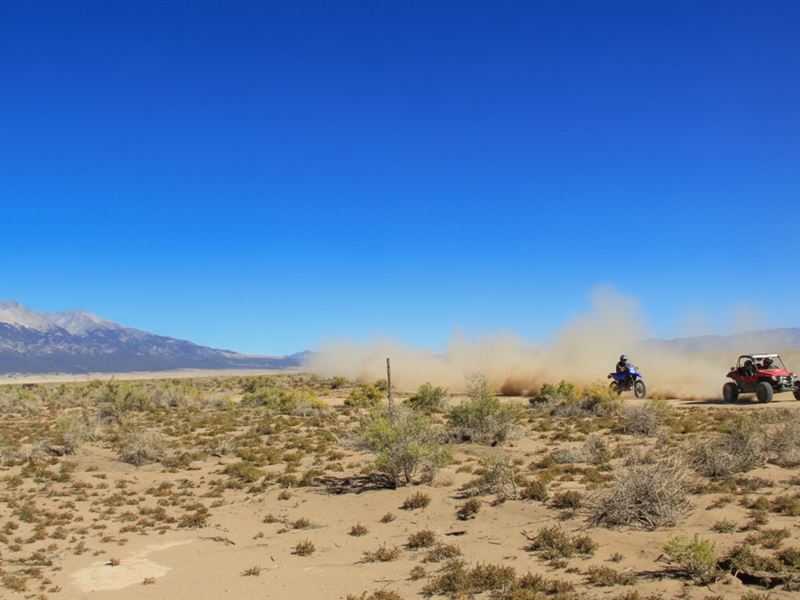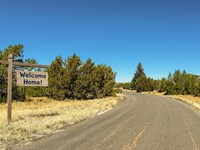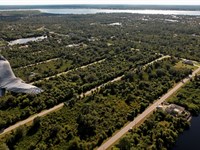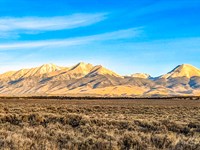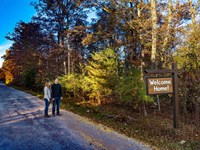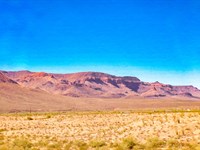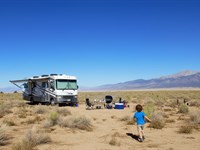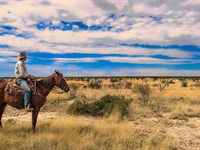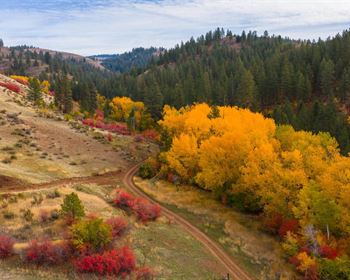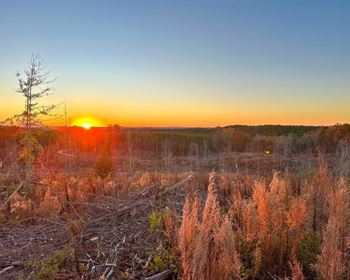1.34 Acres, Sangre Views Await
Alamosa, CO 81101
Costilla County, Colorado
Land Description
1.34 acres of wide-open Colorado land where you can finally build the life you've been dreaming about. This property in Deer Valley Meadows gives you the freedom to create exactly what you want-whether that's a cozy tiny home, a manufactured house, or an RV setup for weekend getaways. The land sits in Alamosa County, where big skies meet mountain views and every day feels like a fresh start. Power lines run nearby, making it easier to get connected, and a maintained dirt road gets you right to your property without the hassle.
The surrounding area is pure Colorado at its best. You're close to the Alamosa National Wildlife Refuge, where thousands of sandhill cranes and other birds make their seasonal home. It's a nature lover's playground with hiking, wildlife watching, and endless photo opportunities. The San Luis Valley spreads out around you with the Sangre de Cristo Mountains rising to the east-some of the most dramatic peaks in the state. This is the kind of place where you can actually see the stars at night and enjoy the peace of wide-open spaces.
Whether you're ready to build now or holding onto this for your future escape plan, this property gives you options. Bring your RV for extended stays with a six-month permit, or break ground on that tiny house you've been sketching out. You're not paying ridiculous HOA fees or answering to a board about what color you can paint your mailbox. This is your chance to own real land in Colorado without breaking the bank-a place where you can disconnect from the noise and reconnect with what matters.
We are open to owner financing as well - here is what that would look like:
- Total Money Down: $599($349 downpayment + $250 closing cost)
- Monthly: $125/Month for 72 months
See Info below.
- Subdivision: Deer Valley Meadows
- State: Colorado
- County: Alamosa
- Zip:
- Size: 1.34
- Parcel: 13
- Legal Description: Deer Valley Meadows Lot 13 Blk H Unit 3 1.34 Ac
- Approximate Lat/Long Coordinates:
37.4599, -105.6799 W
37.4604, -105.6793 N
37.4596, -105.6796 Sw
37.4596, -105.6788 Se
- Annual Taxes: Approximately 14.43/Year
- Zoning: Residential Manufactured Home (Rmh)
--- Residential homes allowed
--- Double wide Mobile homes allowed
--- Camping: 6-month RV permits available (requires a septic system)
--- Tiny homes allowed. Minimum build is 500sq ft
- Hoa/Poa: No
- Improvements: None
- Access: Agate Dr.
- Water: Would require well or alternative.
- Sewer: Would require septic system.
- Utilities: Contact Xcel Energy or use alternative power.
Note: Information presented on this page is deemed accurate, but is not guaranteed. Buyer is advised to do their own due diligence
- Fall Colors and Ideal Weather: Autumn in the San Luis Valley, particularly September and October, delivers weather that many consider the finest of the year. Daytime high temperatures moderate from summer's warmth into comfortable 60s and 70s, nighttime lows drop into the 30s and 40s creating crisp sleeping weather, and storms that do arrive typically clear quickly leaving crystalline blue skies and freshly snow-dusted peaks in the distance. The aspen trees that grow in patches throughout the surrounding mountains transform into gold during late September and early October, creating spectacular color displays against the deep green of spruce and fir forests. Driving through the mountains during peak fall color feels like moving through a landscape painting, with entire hillsides glowing yellow and gold under that special autumn light. The valley floor itself doesn't have many aspens, but cottonwoods along the Rio Grande and its tributaries turn yellow and orange, while agricultural fields take on golden hues as crops ripen or after harvest. This is prime time for outdoor activities before winter arrives - hiking, mountain biking, fishing, hunting, and camping all hit their stride as weather remains pleasant but summer's crowds have gone home. November brings more variable conditions as winter approaches, with some days still feeling like fall while others deliver the season's first serious snowstorms and sustained cold temperatures.
- Terrain That Welcomes Building and Development: Your 1.34-Acre parcel sits on terrain typical of the San Luis Valley floor - relatively flat to gently sloping land that presents minimal challenges for construction and development. Unlike mountain properties where steep slopes, rock outcrops, and drainage issues complicate building, valley floor lots offer straightforward sites where excavation, foundation work, and utility installation proceed without extraordinary measures or expenses. The soil composition in Deer Valley Meadows consists of sandy loam and gravelly soils deposited over millennia by ancient lake beds and alluvial processes. This soil type provides good drainage and stable foundation support when properly compacted, allowing standard foundation designs from simple piers for manufactured homes to full basements for site-built houses depending on your budget and preferences. The flat terrain means you won't need extensive grading to create level building pads, saving thousands of dollars compared to hillside lots requiring cut-and-fill operations. Access across your lot for construction equipment, material deliveries, and utility installation will be straightforward rather than requiring special arrangements for steep or rocky access. The gentle topography also simplifies septic system installation by providing adequate slope for leach fields without requiring pump systems or mound designs needed in areas with high water tables or flat terrain.
- Soil Quality and Growing Conditions: While the San Luis Valley receives limited precipitation and has a short growing season due to high altitude, the soil quality and intense sunshine create surprisingly productive conditions for gardening and small-scale agriculture if you provide supplemental water. The valley's agricultural economy has historically centered on hay, potatoes, barley, and other crops suited to cool season growing, proving that this climate and soil can produce abundantly with proper management. For home gardeners and small homesteaders, raised beds or in-ground gardens amended with compost and organic matter will grow excellent vegetables during the brief but intense summer growing season. Frost-free days typically run from late May or early June through mid-September, giving you roughly 90 to 110 days to work with - short compared to lower elevation areas but sufficient for many varieties. Cold-hardy crops like peas, lettuce, radishes, and spinach can be planted earlier and later to extend the season, while heat-lovers like tomatoes, peppers, and squash need to be started indoors and transplanted as seedlings to ensure they have enough time to mature before fall frost kills them back. The intense solar radiation at 7,500 feet elevation means plants photosynthesize more efficiently and produce higher concentrations of beneficial compounds compared to the same varieties grown at sea level. Many gardeners report that carrots taste sweeter, lettuce stays less bitter, and tomatoes develop more complex flavors when grown in high altitude mountain conditions.
Off-Grid Living Potential
- Solar Power in Colorado's High Country: The San Luis Valley ranks among the best locations in the continental United States for solar power generation, combining high elevation, thin atmosphere, and abundant clear days to deliver solar resource levels that rival the Southwest's famous sun belt. At 7,500+ feet elevation, your property receives roughly 15 to 20 percent more solar radiation than sea level locations at similar latitudes because there's less atmosphere for sunlight to travel through and less water vapor and pollution to scatter or absorb photons before they reach the ground. The valley averages over 300 sunny days per year, meaning solar panels produce at or near their rated capacity on most days rather than being compromised by clouds and overcast conditions. Even during winter months when days are shorter and the sun's angle is lower, the valley's clear skies and snow-reflected light keep panels producing substantial power. In fact, cold temperatures actually improve solar panel efficiency because photovoltaic cells operate more efficiently when cool, partially offsetting the reduced daylight hours during winter. A well-designed off-grid solar system for a modest home in the San Luis Valley might include 4,000 to 8,000 watts of solar panels, a battery bank with 10 to 20 kilowatt-hours of storage capacity, a charge controller to manage power flow, and an inverter to convert DC battery power into household AC electricity. System costs have dropped dramatically over the past decade, with complete off-grid packages now running $15,000 to $35,000 depending on size and component quality.
- Water Solutions for Independence: Achieving water independence on your property centers on drilling a successful well that provides adequate flow for household needs, though water hauling remains a viable backup or temporary option during development. The San Luis Valley sits atop substantial groundwater resources, with the unconfined aquifer system underlying the valley floor containing water accumulated from centuries of mountain snowmelt percolating down through underground geology. This aquifer isn't unlimited - sustainability concerns have arisen as agricultural pumping increased over decades - but domestic wells serving single households draw such small amounts relative to irrigation wells that they typically produce reliably for generations without depleting the resource. Domestic wells in the Alamosa area commonly yield 5 to 20 gallons per minute, more than adequate for a household that might use 100 to 300 gallons per day total including drinking, cooking, bathing, laundry, and toilet flushing. Even at the low end of 5 Gpm, a well can refill a pressure tank and meet normal household demand without anyone noticing flow restrictions. Well water quality in the valley generally tests good to excellent, though as mentioned earlier some areas show elevated naturally occurring minerals that may require treatment. Iron and manganese are common in certain locations, leaving rusty stains on fixtures and giving water a metallic taste until filters or treatment systems remove them. Some wells tap deeper confined aquifers with artesian pressure, meaning water rises in the well casing without pumping, which can reduce pumping costs substantially.
- Propane Systems for Off-Grid Homesteads: Propane provides the perfect complement to solar electricity in off-grid systems by handling thermal loads that would otherwise require enormous amounts of battery storage and solar capacity. Water heating, cooking, and space heating all demand large amounts of energy, and doing these with electricity strains even substantial solar systems. Propane appliances handle these needs efficiently while leaving your solar system to power lights, electronics, refrigeration, and other electrical loads. A propane tankless water heater provides endless hot water on demand using a high-BTU burner that heats water as it flows through a heat exchanger, eliminating the standby heat loss of tank-style heaters and ensuring you never run out of hot water during showers or when running the dishwasher. Propane cooking ranges and ovens provide the instant heat control and reliability that cooks prefer, with no waiting for electric elements to heat up or cool down. For space heating, propane offers multiple options depending on your home design and preferences. Direct-vent wall heaters mount on interior walls and vent through the wall behind them, providing zone heating without requiring ductwork or electricity beyond a small amount for electronic ignition and thermostats. These units are popular in manufactured homes and small cabins where central forced-air systems would be overkill. Propane forced-air furnaces provide whole-house heating through ductwork just like natural gas furnaces in conventional homes, while propane radiant floor heating systems deliver comfortable even warmth by circulating heated water through tubing embedded in concrete floors. Propane tanks come in various sizes, with 500 to 1,000-Gallon tanks being most common for off-grid homes. These tanks are either purchased outright or rented from propane suppliers who fill them on a delivery schedule or when you call for refills.
- Internet and Communication Technologies: Staying connected to the internet for remote work, entertainment, education, and communication poses challenges in rural areas without cable or fiber infrastructure, but modern technologies have created multiple viable solutions. Cell phone coverage in the Alamosa area varies by carrier and exact location, with Verizon typically providing the most extensive rural coverage followed by At&T and then T-Mobile. Even if signal strength is marginal at ground level on your property, installing an external antenna on your roof or a tall mast and connecting it to a cell phone booster amplifier can dramatically improve reception. These boosters retail for $300 to $600 and can transform one or two bars of barely usable signal into four or five bars of reliable service. Cell-based internet through hotspots or phone tethering works well if you have adequate signal strength and a data plan supporting the traffic. Some carriers offer specific rural internet plans with higher data caps or unlimited data suitable for home internet replacing traditional broadband. Starlink satellite internet has revolutionized rural connectivity by providing true broadband speeds with reasonable latency even in locations with no cell coverage whatsoever. Starlink terminals cost approximately $500 to $600 for the hardware plus $110 to $120 per month for service, but they deliver speeds typically ranging from 50 to 200 Mbps with latency low enough for video calls and online gaming. The service works by communicating with a constellation of low-Earth orbit satellites rather than traditional geostationary satellites, eliminating the multi-second delays that plagued older satellite internet and made video calls impossible.
Investment And Market Analysis
- Colorado Land Values and Long-Term Trends: Raw land in Colorado has historically appreciated over long time horizons despite periodic boom-and-bust cycles tied to broader economic conditions and regional development patterns. The San Luis Valley has remained more affordable than Colorado's Front Range mountains or resort areas like Vail and Aspen, but this affordability combined with the valley's natural beauty and recreation access creates opportunity for buyers willing to take long-term positions. Looking back over recent decades, valley land prices started extremely low in the 1960S and 70s when subdivisions like Deer Valley Meadows were first platted and lots sold for hundreds or low thousands of dollars to buyers seeking affordable land ownership. Through the 1980S and 90s, values gradually appreciated to reflect Colorado's growing population and recognition of the valley's assets. The early 2000S housing boom brought speculation and price increases as national attention focused on Western land, followed by the 2008 crash that devastated markets nationwide. Recovery through the 2010S was slow but steady, with the valley benefiting from renewed interest in rural living and Colorado's continued population growth. The Covid-19 pandemic and subsequent remote work revolution triggered another surge of interest in rural properties as people realized they could work from anywhere and sought space, affordability, and lifestyle quality impossible to find in expensive urban markets.
- The Scarcity Principle in Colorado Land: One fundamental factor supporting long-term land appreciation in Colorado is the simple reality that private land represents a minority of the state's total area, with federal and state governments owning approximately 36 percent of Colorado's land base. In the San Luis Valley specifically, Rio Grande National Forest, Great Sand Dunes National Park, Alamosa National Wildlife Refuge, BLM lands, and state trust lands account for huge acreages that will never be available for private ownership. This constrained supply means that as population grows and demand increases, buyers compete for a limited pool of available parcels. Unlike housing where builders can construct new homes to meet demand, land supply is fundamentally fixed - they're not making more of it. When you buy land in a platted subdivision like Deer Valley Meadows, you're acquiring one of a finite number of lots created when that subdivision was recorded. The only way new supply enters the market is when existing owners decide to sell or when rare large ranches get subdivided, and subdivision has become increasingly difficult as regulations tighten and infrastructure costs rise. This supply scarcity doesn't guarantee appreciation in any given year, but over decades it creates upward pressure on values as growing numbers of people seek land in desirable areas with limited availability.
- Colorado Population Growth Driving Demand: Colorado has been one of America's fastest-growing states for over two decades, adding roughly 750,000 residents from 2010 to 2020 alone - a population increase of nearly 15 percent in just one decade. This growth has continued post-pandemic as remote work freed people from needing to live near employment centers in expensive cities. What draws people to Colorado? The combination of outdoor recreation opportunities, four-season climate, relatively strong economy, quality of life, and Western culture attracts everyone from young professionals and families to retirees seeking mountain living. While most growth concentrates along the Front Range urban corridor from Fort Collins through Denver to Colorado Springs and Pueblo, secondary markets throughout the state also benefit. The San Luis Valley's proximity to Front Range cities via Highway 160, combined with dramatically lower housing and land costs compared to mountain towns near Denver, positions it to capture spillover demand from buyers priced out of more expensive areas. Someone who can't afford a $200,000 lot in Summit or Eagle County might find a San Luis Valley property perfectly suited to their budget while still delivering the mountain lifestyle they're seeking. As long as Colorado's economy remains healthy and the state continues attracting net migration from other states, demand pressures should support land values across diverse markets including the San Luis Valley.
- Low Holding Costs Create Patient Investing Opportunity: One compelling advantage of owning raw land in the San Luis Valley from an investment perspective is the extremely low carrying cost allowing you to hold property for years or decades without significant ongoing expenses. Your 1.34-Acre parcel carries annual property taxes of approximately $14.43, which breaks down to roughly $1.20 per month - essentially free compared to any other investment asset. Even if land values stay flat or decline temporarily, you're not losing meaningful money in holding costs the way you would with rental properties requiring maintenance and management, or with stocks and mutual funds charging management fees that erode returns over time. Colorado also imposes no real estate transfer tax on land sales, meaning when you eventually sell you're not paying the state a percentage of the transaction price. You will owe capital gains tax on any profit if you sell for more than your purchase price, but that's a tax on gain rather than a tax on the transaction itself, and long-term capital gains rates of 15 to 20 percent for most taxpayers are lower than ordinary income tax rates. With such minimal carrying costs, you can afford to be patient and hold land through multiple market cycles, waiting for optimal selling conditions rather than being forced to liquidate during downturns because ongoing costs are destroying your returns.
- Exit Strategies and Value Enhancement: Successful land investors think about multiple potential exit strategies and ways to add value before eventually selling. The simplest exit is selling the raw land as-is to another buyer after values have appreciated to your target level or when your investment timeline dictates. Marketing land has become easier with online platforms reaching buyers nationwide who are searching for exactly what you're offering. Another proven exit strategy involves owner financing where you sell the property but carry the loan yourself rather than requiring the buyer to obtain bank financing. Many land buyers prefer owner financing because traditional lenders rarely provide mortgages on raw land. You benefit by selling at a higher price than you'd receive in a cash-only transaction, collecting interest on the loan balance that provides ongoing income, and potentially spreading capital gain recognition over multiple years for tax advantages. If the buyer defaults, you foreclose and repossess the land while keeping all payments received as compensation for their use of the property. Value-add strategies can significantly increase what your land is worth before selling. Improving access by grading roads or adding gravel immediately expands your buyer pool. Installing a well and septic system transforms raw land into developable property worth substantially more to buyers who don't want to deal with those hurdles themselves. Even simple improvements like surveying and marking boundaries, clearing brush, or posting attractive signage can increase perceived value and help your property sell faster at better prices.
Land Maps & Attachments
Directions to Land
From Alamosa, head south on Ross Ave, then turn left at the first cross street onto Fourth St.
Continue on Fourth St for 0.4 miles, then turn left onto US-160 E.
Follow US-160 E for 10.3 miles.
Turn right onto Sunrise Blvd and continue for 1.0 mile.
Turn left onto Agate Dr and continue for 0.2 miles to the property (destination will be on the right).
More Land Details
More Land from Jon and Valari Burnett
 1.2 AC : $14.9K
1.2 AC : $14.9K 0.5 AC : $10.5K
0.5 AC : $10.5K 0.3 AC : $8.9K
0.3 AC : $8.9K 7.1 AC : $18.9K
7.1 AC : $18.9K 0.2 AC : $14.9K
0.2 AC : $14.9K 5.8 AC : $11.9K
5.8 AC : $11.9K 4.7 AC : $14.9K
4.7 AC : $14.9K 0.6 AC : $13.5K
0.6 AC : $13.5K 2.4 AC : $9.9K
2.4 AC : $9.9K 1.3 AC : $6.9K
1.3 AC : $6.9K 20.9 AC : $18.4K
20.9 AC : $18.4K 20 AC : $21.9K
20 AC : $21.9K
